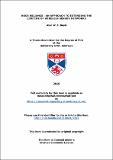Files in this item
Node reliance : an approach to extending the lifetime of wireless sensor networks
Item metadata
| dc.contributor.advisor | Balasubramaniam, Dharini | |
| dc.contributor.author | Boyd, Alan W. F. | |
| dc.date.accessioned | 2010-11-12T16:10:11Z | |
| dc.date.available | 2010-11-12T16:10:11Z | |
| dc.date.issued | 2010 | |
| dc.identifier | uk.bl.ethos.552471 | |
| dc.identifier.uri | https://hdl.handle.net/10023/1295 | |
| dc.description.abstract | A Wireless Sensor Network (WSN) consists of a number of nodes, each typically having a small amount of non-replenishable energy. Some of the nodes have sensors, which may be used to gather environmental data. A common network abstraction used in WSNs is the (source, sink) architecture in which data is generated at one or more sources and sent to one or more sinks using wireless communication, possibly via intermediate nodes. In such systems, wireless communication is usually implemented using radio. Transmitting or receiving, even on a low power radio, is much more energy-expensive than other activities such as computation and consequently, the radio must be used judiciously to avoid unnecessary depletion of energy. Eventually, the loss of energy at each node will cause it to stop operating, resulting in the loss of data acquisition and data delivery. Whilst the loss of some nodes may be tolerable, albeit undesirable, the loss of certain critical nodes in a multi-hop routing environment may cause network partitions such that data may no longer be deliverable to sinks, reducing the usefulness of the network. This thesis presents a new heuristic known as node reliance and demonstrates its efficacy in prolonging the useful lifetime of WSNs. The node reliance heuristic attempts to keep as many sources and sinks connected for as long as possible. It achieves this using a reliance value that measures the degree to which a node is relied upon in routing data from sources to sinks. By forming routes that avoid high reliance nodes, the usefulness of the network may be extended. The hypothesis of this thesis is that the useful lifetime of a WSN may be improved by node reliance routing in which paths from sources to sinks avoid critical nodes where possible. | en_US |
| dc.language.iso | en | en_US |
| dc.publisher | University of St Andrews | |
| dc.rights | Creative Commons Attribution-NonCommercial-NoDerivs 2.5 UK: Scotland | |
| dc.rights.uri | http://creativecommons.org/licenses/by-nc-nd/2.5/scotland/ | |
| dc.subject | WSN | en_US |
| dc.subject | Routing protocol | en_US |
| dc.subject | Wireless | en_US |
| dc.subject | Sensor | en_US |
| dc.subject | Network | en_US |
| dc.subject | Heuristic | en_US |
| dc.subject.lcc | TK7872.D48B7 | |
| dc.subject.lcsh | Sensor networks | en_US |
| dc.subject.lcsh | Wireless LANs | en_US |
| dc.subject.lcsh | Routing protocols (Computer network protocols) | en_US |
| dc.title | Node reliance : an approach to extending the lifetime of wireless sensor networks | en_US |
| dc.type | Thesis | en_US |
| dc.type.qualificationlevel | Doctoral | en_US |
| dc.type.qualificationname | PhD Doctor of Philosophy | en_US |
| dc.publisher.institution | The University of St Andrews | en_US |
This item appears in the following Collection(s)
Except where otherwise noted within the work, this item's licence for re-use is described as Creative Commons Attribution-NonCommercial-NoDerivs 2.5 UK: Scotland
Items in the St Andrews Research Repository are protected by copyright, with all rights reserved, unless otherwise indicated.


